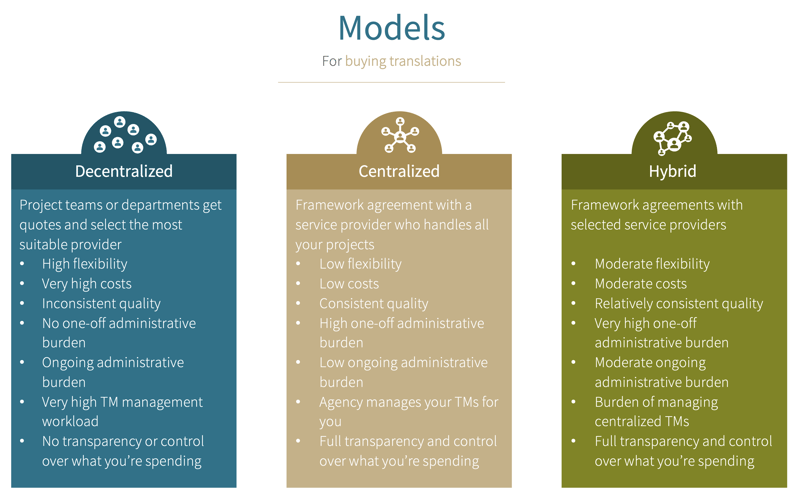
If you’d rather avoid the agony of choice when buying translations, you might decide to put all your eggs in one basket. Thinking strategically can save you lots of time and money – we explain the pros and cons of decentralized, centralized and hybrid models when buying translations.
It sounds simple: all you and your colleagues want is “a translation”. But there are various ways to buy it, each with their own pros and cons.

© MEINRAD: Overview of the three models for buying translations
The decentralized option: lots of translation service providers
If you take a decentralized approach, the departments or project teams responsible for each translation will get quotes from multiple translation agencies. While this eliminates the initial administrative burden involved in establishing a framework agreement, this is replaced by the continuous chore of getting quotes and reviewing them. Once you’ve got all your quotes, you need to compare them – and that often isn’t easy, given that there are different ways of calculating prices. The cheapest provider will usually get the job, but the time taken to establish who that is shouldn’t be underestimated and can be a particular problem if you need a translation quickly. On the other hand, the decentralized model gives you a range of translation agencies to choose from. This reduces the risk of not getting your translation back on time if the translators or project managers at one agency are unavailable that day, as you can simply get a different agency to handle the project. So you get flexibility. But at a price.
Translation memories are invaluable
You’ll rarely get the value for money you might initially expect from the decentralized model. Even if you give your projects to the cheapest provider each time, you’ll miss out on bulk discounts for large volumes of text: framework agreements usually give you the chance to negotiate lower prices than you’ll get from ad hoc orders. And don’t forget the invaluable role that translation memories play. If you have ten different translation service providers (each with their own TMs) and you send one translation to one provider and the next translation to another, not only are you highly likely to get more inconsistent translations, but lots of text will end up being translated two or three times – and you’ll pay for it two or three times too. That’s because each translation agency only has access to its own TMs and won’t know what the other agencies are doing. The other option is to manage your own TMs, if the agencies are happy for you to do that without a corresponding contractual agreement. But that creates a lot of work for you in terms of updating the TM and sending it back and forth between the individual service providers. Ultimately, you have to weigh up whether spreading the risk by taking the decentralized approach is worth the loss of transparency, consistency and control over what you’re paying the various agencies.
The centralized model: buying translations from one service provider
The opposite approach is to put all your translation eggs in one basket, i.e. to send all your translation projects to one service provider. At first this might sound risky and inflexible, but it can benefit you in lots of ways if you find a translation agency you can trust that meets all your requirements. One is that you no longer have to request and compare quotes all the time: once you’ve established a framework agreement, your staff across all departments can simply send projects to the agency safe in the knowledge that the use of TMs and term bases will give you high-quality, consistent translations. And you don’t have to worry about managing the TMs either, as the agency will take care of that for you. Centralizing the process means you’ll have a lot more work for the agency, who can give you bulk discounts as part of the framework agreement and can offer you better and better terms as your long-term business relationship develops. Plus, sending everything to one service provider gives you maximum control and transparency over what you’re spending.
So here’s how you can benefit from the centralized approach to buying translations:
- you pay less thanks to optimized use of TMs and discount options
- consistent translations
- minimal administrative workload
- agency manages your TM for you
- full transparency and control over what you’re spending
- long-term cooperation strengthens business relationships
The hybrid approach: buying translations from selected service providers
If sending all your projects to one service provider is too risky, but you still want to enjoy the benefits of the centralized model, it’s worth considering the hybrid approach. You can focus on a small number of translation agencies and work closely with them. Although that means a lot of administration at the start of the process, from then on you’ll have no more than a moderate workload.
Main Image: © Adobe Stock


